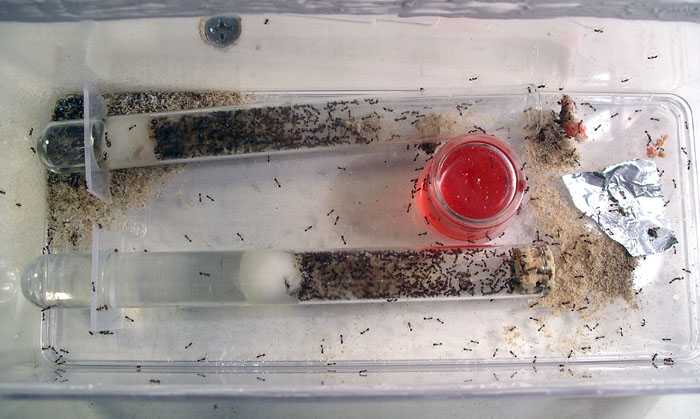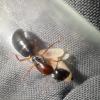Yup, but not by any of the ones I'm keeping. Welcome to the forum BTW. ![]()
- Formiculture.com
- Forums
- Gallery
- Members
- Member Map
- Chat

Yup, but not by any of the ones I'm keeping. Welcome to the forum BTW. ![]()
Update 1-24-2014
I sold the smallest colony through the AntsCanada GAN project, leaving me with just one giant colony, which I am also trying to sell now too. I just don't have any formicarium ready for a colony of that size right now.
Keep adding test tubes and possibly get a bigger tupperware container. ![]()
There is a journal somewhere online where the guy was going to build a formicarium "one day" and just kept adding test tubes - he was up to 12 test tubes.
They are tugging at the cotton on the lid? I thought you had escape barriers in place. I can only imagine how fun feeding must be.
"Always do right. This will gratify some people, and astound the rest." -- Samuel Clemens
Keep adding test tubes and possibly get a bigger tupperware container.
There is a journal somewhere online where the guy was going to build a formicarium "one day" and just kept adding test tubes - he was up to 12 test tubes.
They are tugging at the cotton on the lid? I thought you had escape barriers in place. I can only imagine how fun feeding must be.
Talcum powder works good, but when you have thousands of them trying to crawl over it every second of the day without ever stopping, it eventually wares off.
I guess that would do it.
Let us know when they come to say hi in the middle of the night. ![]()
Might have to try some fluon.
"Always do right. This will gratify some people, and astound the rest." -- Samuel Clemens
I already had a bunch escape. The weird thing is they were all dead on the shelf at the base of the container, so there must have been some sort of strong pesticide sprayed in that cabinet at some point. This also may have something to do with why a few of my colonies in the past suddenly died off as if they had been poisoned. Now I am very careful not to touch the inside of the cabinet and touch anything in the nests. Also if any ants escape I won't put them back in with the colony.
Any update? I can guess you sold it, but still. Also, how large is this queen, and is she fully clausteral?
Edited by Gregory2455, July 10 2014 - 12:10 AM.
How large does the population of one colony get?
Update 7-29-2014
I eventually sold the large colony to some guy about five months ago, and he still hasn't picked it up, so I just decided to keep it and give him his money back. I figured I could probably design a nest specifically to allow me to do time-lapse video of them eating different things, which would be pretty interesting. During the last five months while waiting for that guy to pick them up, the colony grew to well over 1000 workers, but then had a big die-off, and is now back down to just a few hundred. I had to move them into a new container since theirs had so much trash in it. First I tried letting the old tube and container dry out, but they never moved, no matter how dry it got. Finally I tried the hot/cold method, which worked great with these guys. I had their old container sitting in some ice water, while their new one was warmed on a heat pad, and it didn't take long for the whole colony to move over.
About three weeks ago, Chromerust gave me three more S. xyloni queens all in one test tube. They seemed fine together until the workers started eclosing a week later, and then it wasn't long before all three queens were dead. I don't know for sure why they all died, but the workers certainly could have had something to do with it. They dragged all three dead queens out of the test tube at first, but then later I found two of them back inside for some reason. A few days ago, I found a few more S. xyloni queens while running my black light, so I decided to try introducing one of them that didn't seem to be laying eggs to the queenless colony. Right away workers started swarming on her, but I noticed they weren't attacking her or doing anything aggressive, just crawling all over her, rubbing their antennae all over her really fast. I noticed some were licking and cleaning her. I continued watching them through my microscope for a while, and could see they were definitely getting along great with her. Shortly after this they dragged the two dead queens out of the test tube. It certainly looks like they have their queen now.
Those are some epic colonies you have there. I caught 2 Solenopsis Xyloni queens around 2 weeks ago and am interested in any tips you may have for these guys. I am new to ant keeping by the way.
I plan on eventually putting them in a 'natural formicarium', as in a structure with dirt in it. Is there a 'best way' to go about this type of set up? I'm strapped for cash so I can't really go out and get an official formicarium or buy materials to make one myself. Thanks in advance.
The good man is the friend of all living things. - Gandhi
I've never made one before, but I know there is plenty of info out there on making one. Why do you want to put S. xyloni in a formicarium like that as opposed to something that builds interesting mound structures? S. xyloni are always trying to get out too, and will probably be constantly crawling all over the sides and top.
Hello DesertAntz! Welcome to the forum, Solenopsis are easy to keep most of the time, so therefore a good colony to start with if you have them in your region, but they are fire ants, so they do sting. As for the natural nest you plan on making, it is a really good idea, pretty cheap, and I plan on putting one of my S. xyloni queens into one as well, BUT here are some things to look out for.
Species wise,
They Sting
The can walk on the sides and get out with ease,
you can fix that either with a substance you put on the side to make it slippery, and/or a good lid.
Solenopsis xyloni minor workers are pretty small too, so a screen lid with large spaces or anything of the sort is not such a good idea.
Things to do with your natural setup:
The dirt you use should be sterile. Bake it, freeze it, or see the consequences- all you need to do is look in my journal and see my problem with the mites.
The dirt should have different sized particles. From pebbles to silt worked with me when I was experimenting with http://formiculture....4_224_32463.jpg
Also, twigs and other stuff of the sort are also useful to keep it from caving in. (Remember EVERYTHING needs to be sterile.)
Keeping it moist is the most important to prevent cave ins. Not too moist so that mold should start growing, but moist enough to keep it sturdy.
If you want to see the ants tunneling on the side, put an upside down sealed tupperware, or some other sturdy plastic box to keep them from digging in the middle, and fill it with dirt around, and about 1-2 inches above the top of the box. Also, to discourage them to dig on the side of the tupperware instead of the glass, keep the sides of the tank covered with black construction paper until they are well moved in, and keep as much light as you can away from the visible chambers as you can to keep them from moving out of it.
Solenopsis xyloni make massive colonies, so they cannot stay away from the glass forever anyway.
Also note that if you feed them insects from the wild, they need to be sterile as well. Freeze them before you give them to the ants.
What I wrote may not be 100% perfect, this is just how I plan on making mine... If I missed anything or said something wrong, feel free to point it out.
If S. xyloni really is what you want in a setup like this, Gregory2455 pretty much gave you the best advise.
Thanks for your answers!
The good man is the friend of all living things. - Gandhi
Any time! Say, you are from Arizona? You probably have Acromyrmex versicolor in your backyard! ![]()
Update 8-29-2014
First of all I just noticed the queen in my large colony is nowhere to be found anymore, so it obviously died some time back. I guess now I have my test subjects for some experiments I want to try.
The queen that was accepted by the new colony that lost its queen died also.
I recently found four more queens who now have their first workers, so hopefully I can grow one of these colonies as big as the large one I had.
Edit: I just found the queen in my big colony so I guess they aren't doomed after all. ![]() I don't know where she was hiding.
I don't know where she was hiding.
Edited by dspdrew, August 29 2014 - 7:51 PM.
-ToeNhi

Update 10-14-2014
The queen in my large colony has completely stopped laying eggs. I moved her test tube out of the foraging container and just put a stopper back in it again.
The other colonies have all died or been adopted, except one. I just found another one of those queens dead today. The remaining colony does not have very many workers and brood at all.
Ant Keeping →
Ant Keeping Journals →
cooIboyJ's Nylanderia vividula journalStarted by cooIboyJ , Sep 6 2025 |
|

|
||
Ant Keeping →
Ant Keeping Journals →
Ants_Dakota's Camponotus sp. JournalStarted by Ants_Dakota , Jul 13 2025 |
|

|
||
Ant Keeping →
Ant Keeping Journals →
Strickys Formica JournalStarted by stricky_ants , Jun 21 2025 |
|

|
||
Ant Keeping →
Ant Keeping Journals →
AntTx's Camponotus sansabeanus JournalStarted by AntsTx , Jun 17 2025 |
|

|
||
Ant Keeping →
Ant Keeping Journals →
The Bark Battalion (Liometopum occidentale)Started by AntsGodzilla , Jun 3 2025 |
|

|
0 members, 1 guests, 0 anonymous users